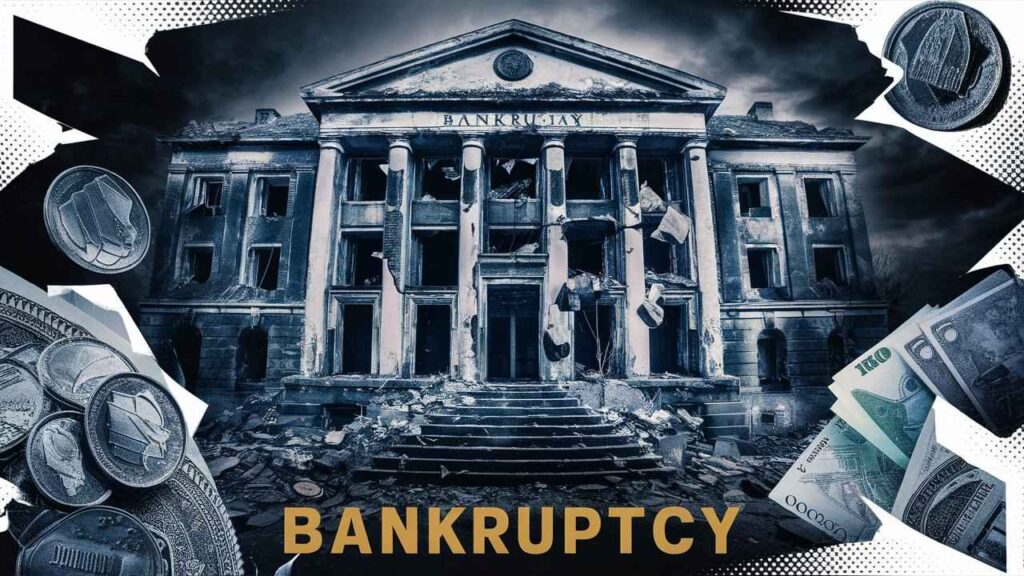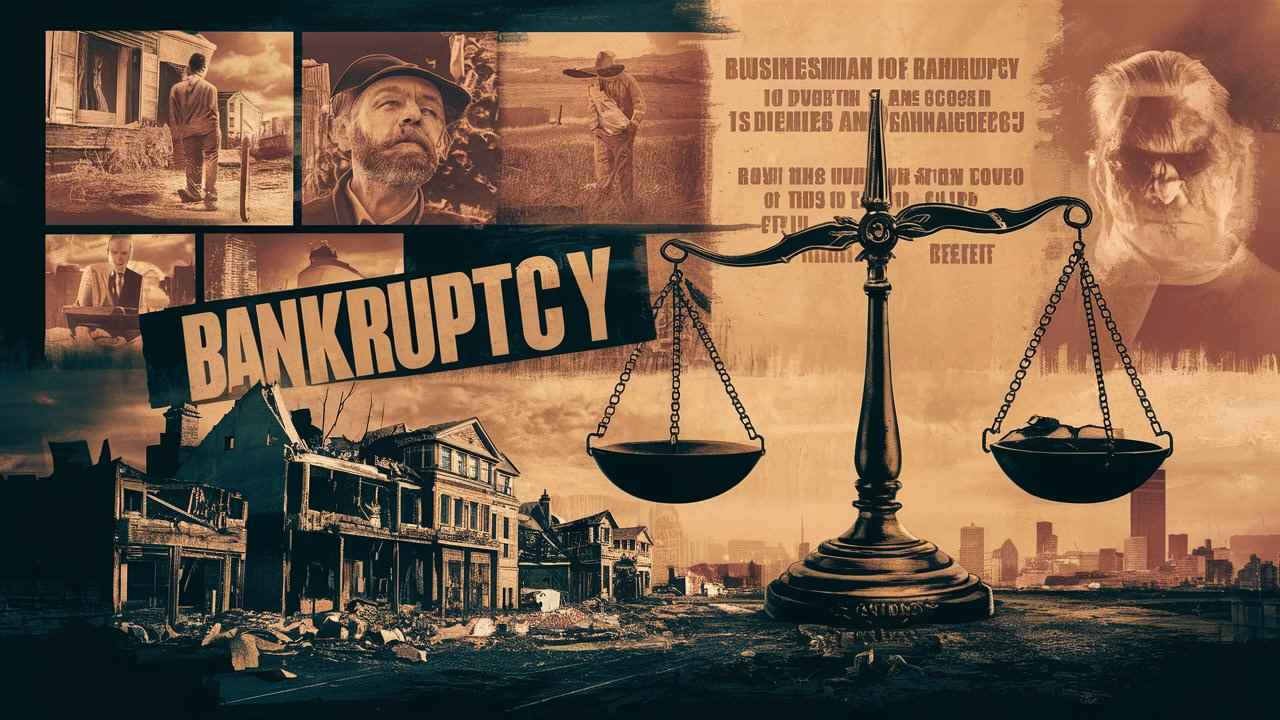Welcome to the Wild World of Bankruptcy
Why This Topic Is Hotter Than Your Ex’s Texts
Let’s face it: Bankruptcy has been getting more buzz than a caffeinated squirrel in a nut factory. It’s like the reality show of the financial world, complete with cliffhangers, surprising twists, and the occasional melodrama. Whether you’re knee-deep in debt or simply curious about the process, understanding bankruptcy can feel like navigating a labyrinth with a blindfold on. But don’t fret! This guide will shine a spotlight on everything you need to know, making it easier to navigate this seemingly scary terrain.

The Not-So-Scary Side of Bankruptcy
Contrary to popular belief, bankruptcy isn’t synonymous with failure. Think of it more like a life reset button, allowing individuals to start anew. The process isn’t as terrifying as it’s cracked up to be💵like a horror movie that turns out to be a romantic comedy. With the right knowledge and approach, you can navigate this wild world and emerge victorious, wearing your proverbial cape of financial freedom.
What Is Bankruptcy? The Basics
Defining Bankruptcy: It’s Not Just for the Movies
At its core, bankruptcy is a legal procedure that allows individuals or businesses to eliminate or repay their debts under the protection of the federal bankruptcy court. No, you won’t find Hollywood dramatizations here💵real-life bankruptcy is far less glamorous than a high-stakes courtroom showdown. Instead, it’s a systematic approach to managing overwhelming financial burdens, like a financial detox for your credit score.
The Purpose of Bankruptcy: A Fresh Start or Just a Fancy Term for Oops?
The primary purpose of bankruptcy is to provide relief from insurmountable debt while offering a clean slate for those willing to embrace it. It’s like a financial phoenix rising from the ashes of fiscal chaos. While some may view it as an admission of defeat, others see it as a strategic move to reclaim control over their financial lives. The choice is yours: embrace it as a fresh start or toss it in the “oops” pile.💵

How Does Bankruptcy Work? The Mechanics
The Bankruptcy Process: A Step-by-Step Guide Without the Legal Jargon
So, how does one embark on this adventure? The bankruptcy process typically involves several key steps:
- Pre-filing credit counseling: Before filing, individuals must attend a credit counseling session to explore their options. Think of it as your financial therapy session.
- Filing the petition: This is where the magic happens! You submit your bankruptcy petition to the court, along with all the necessary paperwork detailing your financial situation.
- Automatic stay: Once the petition is filed, an automatic stay goes into effect, halting most collection activities. It’s like hitting the pause button on your financial woes.
- 341 meeting of creditors: Here’s your chance to face the music💵sort of. This meeting allows creditors to ask questions about your financial status.
- Discharge of debts: After completing the required steps, the court discharges your eligible debts, allowing you to start anew. Cue the confetti!
Automatic Stay: Your Financial Superhero
Picture this: you’re about to be tackled by a horde of angry creditors, and just as they leap toward you, an invisible force field swoops in to protect you. That’s the automatic stay! This powerful legal protection halts most collection activities, giving you breathing room to navigate the bankruptcy process without the constant pressure of debtors knocking at your door.

Different Types of Bankruptcy: Choosing Your Adventure
Chapter 7 Bankruptcy: The Quick Escape Route
If you’re looking for a swift exit from the debt jungle, Chapter 7 bankruptcy might be your ticket out. Often referred to as “liquidation bankruptcy,” it allows individuals to discharge most unsecured debts, like credit card balances and medical bills, in a matter of months. However, there’s a catch: you must meet certain income qualifications, and some assets may be liquidated to repay creditors. Think of it as the fast pass at a theme park, but without the rollercoaster of emotions.💵
Chapter 13 Bankruptcy: The Long, Winding Road to Debt Freedom
For those with a steady income who want to keep their assets, Chapter 13 bankruptcy offers a structured repayment plan spanning three to five years. It’s akin to a financial marathon, where you gradually chip away at your debts while enjoying the comforts of your belongings. While it takes longer, many find this path more manageable, like navigating a scenic route with pit stops along the way.
Chapter 11 Bankruptcy: For When You’re Too Fancy for the Rest
Often associated with corporations, Chapter 11 bankruptcy allows businesses to reorganize their debts while continuing operations. Think of it as a business makeover reality show where the goal is to emerge stronger, with a revitalized financial strategy. While it’s less common for individuals, high-asset filers sometimes find it necessary to seek this option, like the entrepreneur who’s been too busy to update their business plan.💵
Chapter 12 Bankruptcy: The Farmer’s Friendly Option
Farmers and fishermen, rejoice! Chapter 12 bankruptcy is tailored to your unique financial challenges. This special provision allows those in the agricultural sector to propose a repayment plan while keeping their operations running smoothly. It’s like a lifeline thrown to those who nourish the nation💵ensuring that crops keep growing and the fish keep swimming.

Which Type of Bankruptcy Is Right for You? The Decision-Making Process
Assessing Your Financial Situation: The Good, the Bad, and the Ugly
Before diving headfirst into the bankruptcy pool, take a long, hard look at your financial landscape. Evaluate your income, expenses, assets, and debts. Are you swimming in a sea of medical bills and credit card debt? Or are you grappling with a mountain of student loans? Identifying the depth of your financial woes will help you choose the right type of bankruptcy, much like picking the correct potion in a wizarding world.💵
Questions to Ask Yourself Before Deciding
As you ponder your options, consider these reflective questions:
- What type of debts do I have? Understanding whether your debts are secured or unsecured will influence your bankruptcy choice.
- Can I maintain my current lifestyle? Evaluate whether you can keep your home, car, or other significant assets during the process.
- What are my long-term financial goals? Consider what life looks like after bankruptcy💵what financial dreams are you aiming for?
Answering these questions can guide you toward the best course of action, like a financial GPS.

What Debts Can Be Discharged? The Sweet Relief
Secured vs. Unsecured Debt: What’s the Difference, Anyway?
When it comes to bankruptcy, not all debts are created equal. Secured debts are tied to specific assets, like a mortgage or car loan, where the lender has the right to reclaim the property if you fail to pay. Unsecured debts, on the other hand, include things like credit card balances, medical bills, and personal loans, which don’t have collateral backing them. Think of it as a financial game of tag, where secured debts hold onto their assets, while unsecured debts are free to roam.💵
The Surprising List of Debts That Won’t Disappear
While bankruptcy can wipe the slate clean for many debts, some pesky obligations remain. Student loans, child support, and certain tax debts are notoriously resilient. It’s like the financial version of “Guess Who?”💵you may eliminate several options, but some cards will always remain standing.

The Role of the Bankruptcy Trustee: Your New Best Friend
Who’s the Trustee? Not Just a Fancy Title
Meet your bankruptcy trustee, the unsung hero of the process. This individual, appointed by the court, plays a pivotal role in overseeing your case. Think of them as your financial referee, ensuring that the game stays fair while guiding you through the intricacies of bankruptcy law.
Responsibilities of the Trustee: Part Financial Detective, Part Negotiator
Your trustee wears many hats. They review your financial paperwork, assess your assets, and negotiate with creditors on your behalf. They’re like a financial Swiss Army knife💵part detective, part negotiator💵helping you navigate the stormy seas of bankruptcy while keeping the creditors at bay.
The Impact of Bankruptcy on Your Credit Score: Is It the End of the World?
How Bankruptcy Affects Your Credit: Spoiler Alert, It’s Not Great
Brace yourself: filing for bankruptcy will have an impact on your credit score. While it’s not an immediate apocalypse, it can cause a significant dip, like a rollercoaster plummeting down its first drop. The good news? This dip is temporary, and with diligence, you can recover over time.💵
Tips for Rebuilding Your Credit After Bankruptcy: Dusting Yourself Off
Once the storm has passed, it’s time to start rebuilding. Here are some strategies to help restore your credit score:
- Obtain a secured credit card: This helps you demonstrate responsible credit usage while limiting your risk.
- Pay bills on time: Timely payments are your golden ticket to reclaiming your financial reputation.
- Monitor your credit report: Keep an eye on your progress and dispute any inaccuracies.
Like a phoenix rising from the ashes, you can emerge from bankruptcy with a rejuvenated credit score.
Can You Keep Your Stuff? The Asset Protection Debate
Exempt vs. Non-Exempt Assets: What’s Yours Is Yours (Maybe)
When it comes to bankruptcy, not all assets are created equal. Exempt assets, like certain retirement accounts, your primary home, and essential personal property, are protected during the process. Non-exempt assets, on the other hand, may be subject to liquidation to repay creditors. It’s like a financial game of keep-away💵what you can hold on to depends on the rules of the game.
The Myth of Losing Everything: Spoiler💵You Can Keep Your Underwear
Contrary to popular belief, filing for bankruptcy doesn’t mean losing everything, including your prized collection of unicorn figurines. Many individuals retain most of their belongings, as exemptions protect essential assets. So, rest assured: your underwear and a few cherished items can likely remain safe and sound!
Filing for Bankruptcy: A Walk Through the Paperwork
Pre-Filing Requirements: What You Need to Know
Before diving into the bankruptcy waters, you must meet certain pre-filing requirements. This includes attending a credit counseling session and gathering essential documents, like tax returns, bank statements, and a list of your debts. Think of it as packing your bags for a vacation💵ensuring you have everything you need for the journey ahead.
The Actual Filing Process: Grab Your Paperwork and Get Ready
Once you’ve gathered your documents, it’s time to file your petition with the bankruptcy court. This involves completing a series of forms that detail your financial situation, like a comprehensive financial autobiography. Once submitted, the court will assign a trustee, and the real fun begins!💵
Common Myths About Bankruptcy: Let’s Bust Those!
Myth 💵1: Bankruptcy Means You’re a Failure
Not true! Many successful individuals have filed for bankruptcy at some point in their lives. It’s a tool for regaining control, not a badge of shame.
Myth 💵2: You Can’t Ever Get Credit Again
Spoiler alert: you can! While it may take time, many people rebuild their credit and secure new loans post-bankruptcy.
Myth 💵3: Only the Poor File for Bankruptcy
This myth couldn’t be further from the truth. People from all walks of life face financial challenges, and bankruptcy is a legal remedy accessible to anyone in need.
What Happens After You File? The Waiting Game
The 341 Meeting of Creditors: The Fun Part
After filing, you’ll attend the 341 meeting of creditors💵a unique gathering where your creditors can question you about your finances. While it may sound daunting, this meeting often feels more like a casual chat with a few curious onlookers. It’s your chance to clarify any misunderstandings and set the record straight.
How Long Does the Process Take? Patience is a Virtue
The bankruptcy process isn’t a sprint; it’s more like a leisurely jog in the park. Depending on your chosen chapter, it can take anywhere from a few months to several years. While waiting may test your patience, remember: good things come to those who wait!💵
Bankruptcy and Your Taxes: Can You Escape Uncle Sam?
Tax Obligations During Bankruptcy: Yes, You Still Have to Pay
Filing for bankruptcy doesn’t give you a free pass on taxes. You’re still responsible for any tax debts, and the IRS will likely want its piece of the pie. So, don’t plan on avoiding Uncle Sam just yet!
Tax Refunds and Bankruptcy: What You Need to Know
When it comes to tax refunds, the rules can get murky. In many cases, your tax refund may be considered an asset and could be used to pay off creditors. Be sure to consult with your trustee to understand how your specific situation might affect your tax refunds.💵
Alternatives to Bankruptcy: Exploring Your Options
Debt Settlement: A Different Kind of Negotiation
If bankruptcy isn’t your cup of tea, debt settlement might be worth exploring. This involves negotiating with creditors to settle your debts for less than what you owe. While it can be effective, be aware that it may impact your credit score, similar to the aftermath of a bankruptcy filing.
Credit Counseling: Can They Save the Day?
Credit counseling services offer guidance for managing your debts and developing a plan to pay them off. They’re like your financial cheerleaders, providing support and strategies to regain control over your finances without taking the plunge into bankruptcy.💵
How to Prepare for Bankruptcy: Getting Your Ducks in a Row
Gathering Financial Documents: The Pre-Game Checklist
Before filing for bankruptcy, gather all necessary financial documents. This includes income statements, tax returns, and lists of debts and assets. Think of it as preparing for a big exam💵being organized will make the process smoother.
Speaking with a Bankruptcy Attorney: What to Expect
Consulting with a bankruptcy attorney is crucial in navigating this complex process. They’ll guide you through your options, help you understand the paperwork, and develop a tailored strategy. Consider them your financial Sherpa, leading you through the bankruptcy mountain range.
Rebuilding Your Life After Bankruptcy: The Comeback Story
Setting New Financial Goals: Aim High!
Once you’ve emerged from the bankruptcy wilderness, it’s time to set new financial goals. Whether you dream of buying a home, starting a business, or simply achieving financial stability, aim high and create a roadmap to guide you toward success.💵
Finding Resources and Support: You’re Not Alone
Rebuilding your financial life after bankruptcy can be daunting, but numerous resources and support networks are available. From financial education programs to support groups, seeking help along the way can make all the difference. You’re not alone on this journey💵many have walked the same path and emerged stronger!
Conclusion: Embracing the New You Post-Bankruptcy
The Bright Side of Bankruptcy: More than Just a Financial Reset
Filing for bankruptcy can be a transformative experience. While it may seem overwhelming, embracing this opportunity for a fresh start can lead to newfound financial wisdom and resilience. It’s a chance to shed old habits and emerge as a more financially savvy individual.
Final Thoughts: Laughing Your Way to Financial Freedom
As you navigate the wild world of bankruptcy, remember that humor can be a powerful tool. Embrace the journey with a light heart and a determined spirit. Financial freedom is possible💵so laugh your way through the process, and remember: every end is just a new beginning.
Frequently Asked Questions About Bankruptcy: Your Curiosities Answered
Common Questions People Ask When Considering Bankruptcy
- Will I lose my home? Not necessarily! Many individuals keep their homes through exemptions.
- 💵How long will *bankruptcy* stay on my credit report?💵 Generally, it remains for seven to ten years, depending on the chapter filed.
- 💵Can I file for *bankruptcy* more than once?💵 Yes, but there are specific waiting periods between filings.
Resources for More Information: Because Google Isn’t Always Right
To ensure you’re well-informed, consult reliable resources, such as the U.S. Courts website, your local bankruptcy court, or a qualified attorney. These resources can help clarify any lingering questions and guide you toward the best path forward on your journey through bankruptcy.
People Also Ask
What is Chapter 7 Bankruptcy?
Chapter 7 bankruptcy, often referred to as “liquidation bankruptcy,” allows individuals or businesses to eliminate most unsecured debts, such as credit card debt and medical bills. In this process, a bankruptcy trustee is appointed to sell off non-exempt assets to pay creditors. The remaining debts are discharged, giving the debtor a fresh financial start. This type of bankruptcy is typically completed in three to six months, making it a quick option for those seeking debt relief.💵
What is Chapter 13 Bankruptcy?
Chapter 13 bankruptcy, known as a “wage earner’s plan,” is designed for individuals with a regular income who want to repay their debts over a set period. In this process, debtors create a repayment plan lasting three to five years, allowing them to catch up on missed payments and keep their assets, such as their home. This chapter is ideal for those facing foreclosure or repossession but who wish to retain their property while paying down their debts.💵
How Long Does Bankruptcy Stay on Your Credit Report?
The impact of bankruptcy on your credit report varies by type. Chapter 7 bankruptcy remains on your credit report for 10 years, while Chapter 13 typically stays for 7 years. While this can significantly affect your credit score, individuals can begin rebuilding their credit sooner by practicing responsible financial habits, such as making timely payments on remaining debts.
Can I Keep My House if I File for Bankruptcy?
Yes, you can often keep your house if you file for bankruptcy, especially under Chapter 13. This chapter allows you to create a repayment plan to catch up on mortgage arrears while keeping your home. In Chapter 7, whether you retain your house depends on the equity you have in it and the exemptions available in your state. If your equity is protected under exemption laws, you can usually keep your home.
What Debts Can Be Discharged in Bankruptcy?
Bankruptcy discharges a variety of unsecured debts, including credit card bills, medical expenses, and personal loans. However, certain debts are typically not dischargeable, such as student loans (unless undue hardship is proven), child support, alimony, and most tax debts. Additionally, secured debts, like mortgages and car loans, can also be discharged, but you may lose the collateral unless you reaffirm the debt.
What Happens to My Credit Score After Bankruptcy?
Filing for bankruptcy results in an immediate drop in your credit score, often between 100 to 200 points. The extent of the impact depends on your financial history prior to filing. However, while bankruptcy can significantly harm your credit score initially, individuals can begin to rebuild their credit with responsible financial behaviors, such as making on-time payments and managing new credit responsibly.
How Do I File for Bankruptcy?
Filing for bankruptcy involves several steps:
- Complete Credit Counseling: You must take a credit counseling course from an approved provider before filing.
- Gather Financial Documents: Collect all necessary financial information, including income statements, tax returns, and a comprehensive list of debts and assets.
- Fill Out Bankruptcy Forms: Complete the required bankruptcy forms accurately.
- File with the Court: Submit your forms to the bankruptcy court and pay the filing fee.
- Attend the 341 Meeting: This is the meeting of creditors where you will discuss your financial situation with a trustee.
Do I Need a Lawyer to File for Bankruptcy?
While you can technically file for bankruptcy without a lawyer, it’s highly advisable to seek legal assistance. Bankruptcy law can be complex, and an attorney can guide you through the process, help you complete the paperwork correctly, and represent your interests in court. Hiring a lawyer can greatly reduce the chances of errors or complications that could arise during your case.
What is a Bankruptcy Trustee?
A bankruptcy trustee is a court-appointed official who oversees your bankruptcy case. Their role includes reviewing your financial documents, administering your bankruptcy estate, and ensuring that creditors are treated fairly. In Chapter 7, the trustee may sell non-exempt assets to pay creditors, while in Chapter 13, they help administer the repayment plan and collect payments from you.
Can I File for Bankruptcy More Than Once?
Yes, you can file for bankruptcy more than once, but there are specific waiting periods between filings. If you previously filed for Chapter 7 bankruptcy, you must wait eight years before filing again. If you filed for Chapter 13, you can file for Chapter 7 after six years or for another Chapter 13 after two years. However, the circumstances of each case will be reviewed, and there may be additional requirements.
What Assets Are Protected in Bankruptcy?
Certain assets are protected under bankruptcy exemptions, which allow you to keep essential property. Commonly exempt assets include your primary residence, a personal vehicle, retirement accounts, and basic household goods. The specifics of these exemptions vary by state, so it’s important to consult local laws or a bankruptcy attorney to understand what you can protect.
How Much Does It Cost to File for Bankruptcy?
The cost of filing for bankruptcy varies based on the type. Filing fees generally are around $338 for Chapter 7 and $313 for Chapter 13. Additionally, if you hire a lawyer, legal fees can range from $1,000 to $3,500, depending on the complexity of your case and your location. Many attorneys offer payment plans to help manage these costs.
How Does Bankruptcy Affect My Taxes?
Filing for bankruptcy does not eliminate your tax obligations, but some tax debts may be dischargeable if they meet certain criteria. Recent tax debts and tax liens are typically not dischargeable. If you receive a tax refund during your bankruptcy case, the trustee may consider it part of your bankruptcy estate, potentially using it to pay creditors, depending on your exemptions.
What Should I Do Before Filing for Bankruptcy?
Before filing, take the following steps:
- Gather Financial Documentation: Compile tax returns, bank statements, and a complete list of debts and assets.
- Complete a Credit Counseling Course: This is a mandatory step before filing.
- Assess Your Financial Situation: Understand your debts and explore alternatives to bankruptcy, if applicable.
- Consult a Bankruptcy Attorney: Legal advice can help you determine the best course of action and prepare for the filing process.
Can I Discharge Student Loans in Bankruptcy?
Discharging student loans in bankruptcy is notoriously difficult. Generally, you must prove “undue hardship” through a separate legal process called an adversary proceeding. Courts use various tests to assess hardship, and successfully discharging student loans is rare but possible under extreme financial circumstances.
What Happens to My Business if I File for Bankruptcy?
The fate of your business in bankruptcy depends on the type you file. In Chapter 7, you may be required to liquidate your business assets, whereas Chapter 11 or Chapter 13 may allow you to restructure debts and continue operations. It’s crucial to consult a bankruptcy attorney to determine the best strategy for your business situation.
How Do I Rebuild My Credit After Bankruptcy?
Rebuilding credit after bankruptcy involves several key steps:
- Create a Budget: Manage your finances to avoid falling back into debt.
- Make Timely Payments: Pay all remaining debts on time, as this will positively impact your credit score.
- Consider Secured Credit Cards: These can help you rebuild credit if used responsibly.
- Monitor Your Credit Report: Regularly check your credit report for errors and track your progress.











